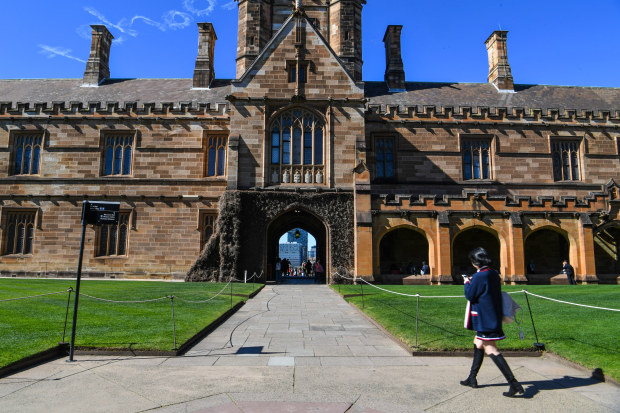Opinion

It’s time to reshape universities for national good
Our tertiary institutions are a national asset, but collaboration with industry is a missed opportunity and should be a focus of the review now under way.
Innes WilloxContributorAustralia’s university sector is undeniably one of our greatest national assets. Our higher education system has world-class institutions, world-leading frameworks for funding and access, and some world-beating research.
But Australia seems to have a peculiar problem. Despite most of our institutions sitting in big cities or towns, we rank near the bottom of the OECD league table on university-industry collaboration.
This seems like a significant missed opportunity, and something that should be a key focus of the university accord review now under way.

There is much scope to boost universities’ contribution to the future economy. Louise Kennerley
Australia’s universities are looking to tackle some of these big challenges, as well as build the human capital of the nation. So is government. So is industry, in many different and complementary ways. Why can’t we leverage more of the resources and capability held in universities more effectively?
Australian businesses often report that they have had to give up dealing with universities because it’s too hard. Even finding the right door or the right person to call takes a while. Once a connection has been made, it can be a real struggle to get on the same page.
It’s as if universities and businesses are at the same party but circle around like awkward teenagers on opposing sides of the dance floor.
Why? In many cases, it’s likely that they haven’t wanted or needed to get together because the incentives have not been there.
Why the gold star?
The things that matter when it comes to money in the door for a university are the number of students enrolled, research output and international rankings. There’s no gold medal for university-industry collaboration.
Maybe there should be.
Just imagine the potential productivity gains across other parts of our society if we made much better use of the wealth of knowledge and capability held by universities.
Imagine teaching content available to more people in more innovative ways, deep expertise and knowledge used in private sector or government projects through consulting, groundbreaking research applied more quickly to real word problems, innovative models of learning and earning concurrently.
This does happen now. But it doesn’t happen nearly as much as it could (or should). In Australia, we still highlight instances of this type of collaboration and give them a gold star – but this should be much more common practice and become business as usual.
The key to thriving in an increasingly complex and dynamic world is having the skills, capabilities and knowledge to be ahead of the game.
Universities should be building the capability not just of the next generation, but also the current workforce, and working with industry and government to solve big problems. We need to get maximum return on our considerable public investment.
More nuance needed
The truth is, in recent decades some universities have been in a good paddock, while others have had to work hard just to survive. Yet, the policy and funding framework has been one size fits all. It’s now a mature and diverse sector with a range of institutions, each with different strengths and weaknesses, serving different communities.
It’s time for a more strategic, nuanced approach.
Nothing should be static, least of all a university. The world is changing, and universities should be at the forefront of that change, not fighting against it. The universities of the future should be dynamic, outward looking, engaging places. The gates should be well and truly open to world.
So, how can we make it happen?
Like everything in life, get the motivation right, and you’re halfway there. Most universities derive a large proportion of their funding from the federal government. There’s a combination of complicated frameworks but – bottom line – the government writes the biggest cheques.
The government effectively controls most of the policy settings and levers – there’s considerable scope to set priorities and influence behaviour.
This may be a shift, but universities serve a public good that is greater than the agenda of any one institution.
The accord expert panel has a difficult task. There are some big questions to consider. But giving Australia’s universities the motivation (and means) to work more effectively with industry and government on shared challenges should be central to our vision for the future. The results might surprise us all.
Introducing your Newsfeed
Follow the topics, people and companies that matter to you.
Find out moreRead More
Latest In Health & education
Fetching latest articles